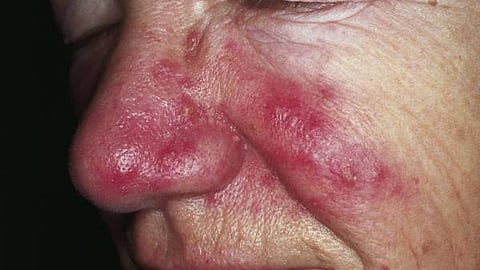

Rosacea is a common skin condition that affects at least 14 million U.S. adults and commonly appears as a tendency to blush or flush more easily than others. While treatable, symptoms, such as skin thickening and eye problems, can often be uncomfortable and affect people’s quality of life.
“With rosacea, there can be many triggers that will worsen symptoms or cause a flare-up,” said Lycia Thornburg, MD, FAAD, a board-certified dermatologist in Rapid City, S.D. “It’s possible to control your rosacea and even prevent it from getting worse by recognizing and avoiding triggers, ranging from alcohol to sunlight to the skin care products you use.”
Signs and symptoms of rosacea include:
Flushing and redness in the center of the face
Swollen skin
Skin may be very sensitive, sting, or burn
Visible broken blood vessels
Acne-like breakouts, usually where the skin is very red, that tend to come and go
Oily skin
To help manage your rosacea symptoms, Dr. Thornburg and the AAD recommend following these seven tips to update your skin care routine:
Choose rosacea-friendly products. Look for products that say they are noncomedogenic (non-pore clogging) and are made for sensitive skin. Many ingredients can irritate sensitive skin and cause a flare-up. Avoid using products with these ingredients on your face: alcohol; camphor; fragrance; glycolic acid; lactic acid; menthol; sodium laurel sulfate; and urea.
Test skin care products. If you have sensitive skin, test skin care products before using them to reduce your risk of a rosacea flare-up. Apply the product to a quarter-sized patch of skin on the inside of your arm every day for 7-10 days. If your skin is clear after that time, go ahead and use the product.
Cleanse. You might be tempted to skip cleansing if your skin feels irritated, but cleansing up to twice a day will help remove oil and dirt that can make irritation worse. Gently apply your mild cleanser in a circular motion with your fingertips, rinsing off all the cleanser when you’re done — if it stays on your skin, it can cause irritation. Then, gently pat your face dry with a clean towel.
Moisturize every day. Moisturize every day after cleansing, even if your skin feels oily. Moisturizing helps hydrate your skin to reduce irritation and make it feel more comfortable.
Protect from the sun. Seek shade and wear sun-protective clothing, like a wide-brimmed hat or sunglasses with UV protection. Apply a broad-spectrum, water-resistant sunscreen with SPF 30 or higher to all skin not covered by clothing. Look for a sunscreen that contains zinc oxide, titanium dioxide, or both.
Be gentle. Avoid rubbing or scrubbing your face, or using washcloths, facial sponges, or exfoliators as anything that irritates your skin can make rosacea worse.
Use makeup if desired. A yellow-tinted concealer can mask discoloration on skin tones ranging from light to dark. A green-tinted concealer can camouflage redness. Keep in mind that some makeup can irritate your sensitive skin. That’s why dermatologists often recommend water-based or powder makeup, which usually doesn’t irritate rosacea.
While rosacea is a common skin condition, there are others that have similar symptoms, including facial reddening. To determine whether you have rosacea, find a treatment that works best for you, and learn how to avoid triggers, make an appointment with a board-certified dermatologist.
"If you are unable to address your symptoms by making changes to skin care, a dermatologist will be able to develop a personalized treatment plan,” said Dr. Thornburg.
Dr. Thorburg
“There are many factors to consider when treating rosacea, including the possibility that it might not be rosacea".
(Newswise/PP)
